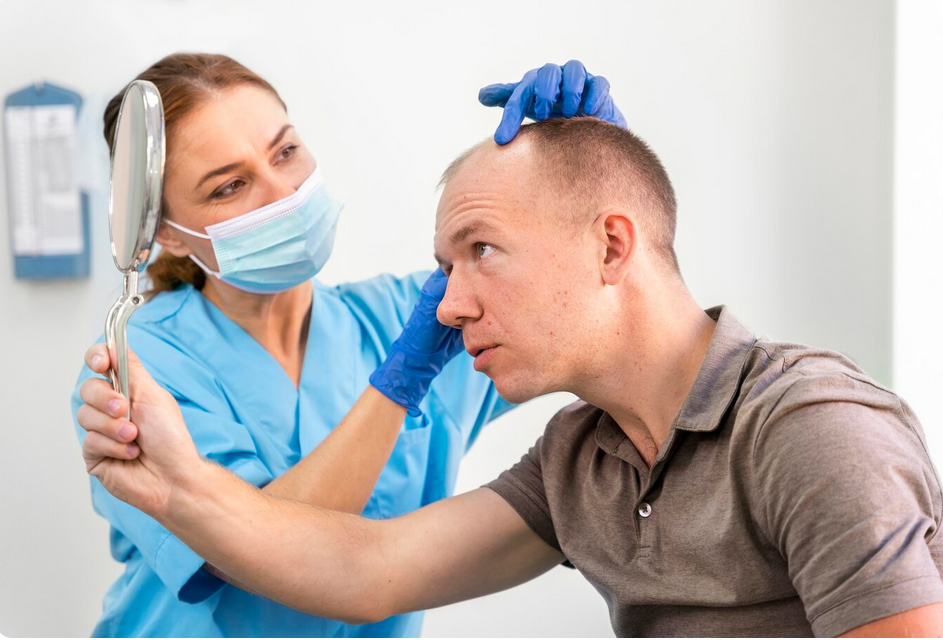Trauma to the scalp—whether from burns, accidents, or surgical procedures—can leave behind lasting scars that affect both appearance and self-esteem. For individuals with visible scalp scarring, Scalp Micropigmentation (SMP) offers a revolutionary, non-surgical solution to restore the natural look of hair follicles and improve overall confidence.
In this guide, we’ll walk you through how SMP works for scar camouflage, what to expect, and why it’s a safe and effective option for many patients with burn or injury-related scalp damage.
What Is Scalp Micropigmentation?
Scalp Micropigmentation (SMP) is a cosmetic tattoo technique that deposits specialized pigment into the scalp using microneedles. It simulates the look of tiny hair follicles and can:
- Recreate the appearance of a fuller head of hair
- Even out patchy areas caused by scarring
- Conceal burn marks or surgical scars
- Restore natural hairlines after trauma
Unlike hair transplants or medications, SMP does not promote hair growth, but it creates the illusion of hair—making it a practical and long-lasting solution for scar camouflage.
How Scalp Scars Affect Hair Growth
Before diving into SMP, it’s important to understand how scars interfere with hair regrowth.
Scar Tissue and Hair Follicles
- Burn scars and accident scars often destroy hair follicles, replacing them with fibrotic tissue.
- This tissue lacks the structure and blood supply needed to support hair regrowth.
- Even with healthy surrounding follicles, the scarred region typically remains bald or patchy.
SMP helps by visually blending these areas with surrounding hair, improving uniformity without requiring hair follicle regeneration.
How SMP Works for Scar Camouflage
Scalp scars vary widely in size, color, texture, and origin. SMP is uniquely adaptable to each type.
Step-by-Step Process:
- Consultation and Scar Assessment
A trained SMP specialist evaluates the scar to determine if it’s suitable for pigmentation (e.g., flat vs. raised, old vs. recent, light vs. dark). - Custom Pigment Matching
The pigment is chosen to match your existing hair color and skin tone for a seamless look. - Micropigmentation Application
The technician deposits pigment into the scar and surrounding scalp to blend the area. Multiple sessions may be required to layer pigment evenly. - Healing and Follow-Up
As the scalp heals, the pigment softens and settles into a more natural tone. A follow-up session fine-tunes the results.
Benefits of SMP for Burn or Accident Scars
- ✅ Camouflages Scars Visibly
SMP reduces the contrast between scar tissue and healthy skin/hair, making scars less noticeable. - ✅ Safe for Most Skin Types
When performed by trained professionals, SMP is safe for most individuals—even those with sensitive or previously damaged skin. - ✅ Non-Surgical and Low-Risk
Unlike grafts or surgical options, SMP does not involve incisions or recovery downtime. - ✅ Boosts Confidence
Many patients report significant improvements in self-esteem and social comfort after treatment. - ✅ Customizable
Whether you want a buzzed look, density in longer hair, or a defined hairline, SMP can be tailored to your needs.
Types of Scars SMP Can Help With
- Burn Scars: Chemical, thermal, or electrical burns that have left smooth or shiny scalp patches.
- Laceration Scars: From accidents, falls, or head trauma requiring sutures or surgery.
- Surgical Scars: From past procedures such as hair transplants, brain surgery, or scalp reconstructions.
- Skin Grafts: SMP can often be applied over grafted areas once fully healed.
Is SMP Right for You?
SMP is a great option if:
- Your scar is fully healed (typically 9–12 months post-injury or surgery)
- The area has no active infection, inflammation, or open wounds
- You’re not prone to keloid scarring (raised, rope-like scars)
- You’re seeking a non-invasive, long-term cosmetic solution
When to Wait or Seek Alternatives:
- If your scar is still healing or undergoing color changes
- If the area is prone to frequent skin irritation or infection
- If you have certain medical conditions like blood disorders or autoimmune skin diseases
Always consult both your doctor and a licensed SMP technician before beginning treatment.
What to Expect During and After SMP
During the Procedure:
- You’ll feel a sensation similar to light scratching or tattooing.
- Sessions typically last 2–4 hours depending on the size of the scar.
- Topical anesthetics may be used for comfort.
Aftercare Guidelines:
- Avoid excessive sweating, swimming, and sun exposure for 5–7 days.
- Keep the area clean and dry.
- Do not pick at healing pigment or scabs.
Long-Term:
- Results last 3–5 years or more, with optional touch-ups.
- Pigment may fade slightly over time, especially with sun exposure.
Choosing the Right SMP Provider
Selecting an experienced provider is critical when dealing with scarred or sensitive skin. Look for:
- Certification and training in medical/trauma-related SMP
- Experience with scar camouflage specifically—not just standard SMP
- Before-and-after photos of similar scar cases
- Use of hypoallergenic, medical-grade pigments
- A clean, licensed facility that follows strict safety protocols
Real Patient Outcomes
Many patients with severe scalp scarring report:
- A dramatic reduction in the visibility of the scar
- Greater willingness to wear shorter hairstyles
- Increased comfort in social and professional settings
- Renewed confidence and self-image
Final Thoughts: Is SMP Worth It for Scar Camouflage?
If you’ve been hiding a scalp scar from an accident, burn, or surgery, Scalp Micropigmentation may be the life-changing solution you’ve been looking for. It provides a safe, effective, and natural-looking option to restore your confidence—without invasive procedures or prolonged recovery.




